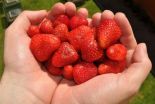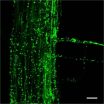(Press-News.org) (Santa Barbara, Calif.) –– Scientists at UC Santa Barbara have demonstrated in the laboratory that a new drug is effective in treating a very common kidney disease –– although it will be a few years before it becomes available for clinical testing. The findings resulted from a collaboration between UCSB and a biotech firm based in Indiana. The study is published in this week's Journal of the American Society of Nephrology.
Over 600,000 people in the U.S., and 12 million worldwide, are affected by the inherited kidney disease known as autosomal-dominant polycystic kidney disease (ADPKD or PKD). The disease is characterized by the proliferation of thousands of cysts that eventually debilitate the kidneys, causing kidney failure in half of all patients by the time they reach age 50. PKD is one of the leading causes of renal failure in the U.S.
The research effort was directed by Thomas Weimbs, associate professor in the Department of Molecular, Cellular, and Developmental Biology. He has been studying the disease for more than a decade. The current findings build on research performed in 2006 in the Weimbs lab, showing that the drug rapamycin, which has been in use for years as an immunosuppressive agent, was highly effective in stopping disease progression in mouse models of polycystic kidney disease.
The previous research by Weimbs came to the attention of Christopher P. Leamon, vice president for research of the biotech firm Endocyte, Inc., which is based in Indiana and focuses on cancer drugs. Leamon was particularly interested in the rapamycin research because Leamon himself has polycystic kidney disease. He immediately contacted Weimbs and flew out to Santa Barbara to develop a research partnership on a new drug for PKD –– based on Weimbs' earlier research.
Weimbs said he was very excited to begin brainstorming ideas with Leamon. "He is at the right place at the right time to do something about his own disease," said Weimbs. "He happens to be the chief scientist at a biopharmaceutical company that may have the technology to make a better drug that could work for PKD patients."
In an earlier study by Weimbs and other researchers, a signaling protein called mTOR was found to drive cyst growth in polycystic kidney disease. Weimbs then found that rapamycin inhibited the growth of cysts, which caused great excitement in the field. However, when the drug was used in large clinical trials in Europe, the results were disappointing. The dose at which this drug could safely be used proved too low to affect kidney cysts.
But Leamon and Weimbs found a way around this problem. Endocyte Inc., Leamon's firm, specializes in linking or "conjugating" small molecules to target diseased cells, primarily cancer cells. Leamon explained that many cancers have a high affinity for folate, and that by linking folate to certain cancer drugs, his company has been successful in targeting cancer cells with these drugs. Leamon and Weimbs wondered if the same strategy could be used in treating the kidney cysts found in PKD. They examined both mouse and human PKD cysts and found that they did, in fact, express folate receptors.
Endocyte chemically synthesized a new version of rapamycin called folate-conjugated rapamycin (FC-rapa). Weimbs' laboratory tested this new drug and found that it was still highly effective in preventing kidney cyst growth in mice with PKD, but that it had fewer systemic side effects compared to regular rapamycin. The results suggest that FC-rapa could also be effective in human PKD patients without causing the significant unwanted side effects of regular rapamycin.
"FC-rapa is a fascinating drug because it combines an extremely specific drug with a delivery approach that targets it to a specific organ, the kidney," said Weimbs. "Rapamycin is already one of the most specific drugs on a molecular level, as it only affects the mTOR protein. The problem is that mTOR is needed in many tissues and organs, which causes the side effects of rapamycin. Delivering rapamycin preferentially to the kidneys –– in the form of FC-rapa –– gets around this problem."
In 2006, based on Weimbs' findings, Leamon began taking regular rapamycin for his diseased kidneys, with the permission of his doctor. The treatment was ineffective, and he eventually had kidney failure. In 2010, he underwent a kidney transplant, thanks to the donation of his sister's kidney, and says he is now in perfect health. However, he remains committed to finding a cure for polycystic kidney disease. "Hopefully, this story is ongoing, and we can find an effective drug for treating this disease," said Leamon.
Weimbs said they will repeat the FC-rapa tests in his lab, and include testing of some similar drugs. "After that, the research may progress to phase one clinical trials for safety, and phase two clinical trials for efficacy," he said.
INFORMATION:
New drug shows promise for kidney disease
2012-08-03
ELSE PRESS RELEASES FROM THIS DATE:
Dangerous experiment in fetal engineering
2012-08-03
CHICAGO --- A new paper just published in the Journal of Bioethical Inquiry uses extensive Freedom of Information Act findings to detail an extremely troubling off-label medical intervention employed in the U.S. on pregnant women to intentionally engineer the development of their fetuses for sex normalization purposes.
The paper is authored by Alice Dreger, professor of clinical medical humanities and bioethics at Northwestern University Feinberg School of Medicine and is co-authored by Ellen Feder, associate professor of philosophy and religion at American University, ...
Bears, scavengers count on all-you-can-eat salmon buffet lasting for months
2012-08-03
Salmon conservation shouldn't narrowly focus on managing flows in streams and rivers or on preserving only places that currently have strong salmon runs.
Instead, watersheds need a good mix of steep, cold-running streams and slower, meandering streams of warmer water to keep options open for salmon adapted to reproduce better in one setting than the other, new research shows.
Preserving that sort of varied landscape serves not just salmon, it provides an all-summer buffet that brown bears, gulls and other animals need to sustain themselves the rest of the year.
"In ...
Invasive insects cause staggering impact on native tree
2012-08-03
The beautiful, endemic and endangered cycad, Cycas micronesica was once a dominant forest tree on the island of Guam, but recent plant mortality predicts extirpation from Guam habitats by 2019. This dire prediction by scientists at the Western Pacific Tropical Research Center (WPTRC), University of Guam is validated by the research of Thomas E. Marler and John H. Lawrence, which has concluded that Cycas micronesica is the only native host for the invasive scale insect Aulacaspis yasumatsui. "The potential cascading ecosystem responses are yet to be completely understood," ...
UT MD Anderson study finds link between depressive symptoms and cancer survival
2012-08-03
HOUSTON — Research from The University of Texas MD Anderson Cancer Center has found that symptoms of depression in patients with newly diagnosed metastatic kidney cancer are associated with survival and inflammatory gene regulation may explain this link.
The study, published in the journal PLoS ONE, further explores the interplay between patient psychological condition, stress hormone regulation and the role of inflammatory gene expression. Although previous research indicates depression is connected with worse outcomes, questions remain about the specific factors involved.
"Our ...
Unexpected variation in immune genes poses difficulties for transplantation
2012-08-03
Human HLA genes – the genes that allow our immune system to tell the difference between our own cells and foreign invaders – are evolving much more rapidly than previously thought, according to an article online on August 3rd in Trends in Genetics. The resulting degree of variation improves our ability to fight off disease, but could also present challenges to current worldwide efforts aimed at identifying potential donors for patients undergoing stem cell transplantation.
"This new work makes clear the daunting and near hopeless challenge of keeping track of the continuous ...
Strawberry extract protects against UVA rays
2012-08-03
An experiment has shown that strawberry extract added to skin cell cultures acts as a protector against ultraviolet radiation as well as increasing its viability and reducing damage to DNA. Developed by a team of Italian and Spanish researchers, the study opens the door to the creation of photoprotective cream made from strawberries.
"We have verified the protecting effect of strawberry extract against damage to skins cells caused by UVA rays," as explained to SINC by Maurizio Battino, researcher at the Università Politecnica delle Marche in Italy and lead author of the ...
How the cell swallows
2012-08-03
VIDEO:
Scientists at EMBL have combined the power of two kinds of microscope to produce a three-dimensional movie of how cells ‘swallow’ nutrients and other molecules by engulfing them. The study...
Click here for more information.
Scientists at the European Molecular Biology Laboratory (EMBL) in Heidelberg, Germany, have combined the power of two kinds of microscope to produce a 3-dimensional movie of how cells 'swallow' nutrients and other molecules by engulfing them. The ...
Bacterial community inside the plant root
2012-08-03
This press release is available in German.Soil is the most species-rich microbial ecosystem in the world. From this incredible diversity, plants specifically choose certain species, give them access to the root and so host a unique, carefully selected bacterial community from which they then benefit in a variety of ways. To achieve this, the plant's immune system must be able to tell which of these bacteria are friends and which foes. Researchers from the Max Planck Institute for Plant Breeding Research in Cologne and the Max Planck Institute for Marine Microbiology in ...
Ethylene of no effect -- why peppers do not mature after picking
2012-08-03
This press release is available in German.Tomato breeders scored a coup several years ago when they identified tomatoes with a genetic defect that made the fruits mature very slowly, even under the influence of the phytohormone ethylene. Traders and growers were delighted as it gave them more time to transport the crop, initially still green, from where it was harvested to where it would be sold. At the stores, the tomatoes could then be treated with ethylene to bring them to maturity. Other fruits, like peppers, grapes and strawberries, generally do not mature after picking; ...
Mystery of elephant infrasounds revealed
2012-08-03
Elephants can communicate using very low frequency sounds, with pitches below the range of human hearing. These low-frequency sounds, termed "infrasounds", can travel several kilometers, and provide elephants with a "private" communication channel that plays an important role in elephants' complex social life. Their frequencies are as low as the lowest notes of a pipe organ.
Although the sounds themselves have been studied for many years, it has remained unclear exactly how elephant infrasounds are made. One possibility, favored by some scientists, is that the elephants ...




